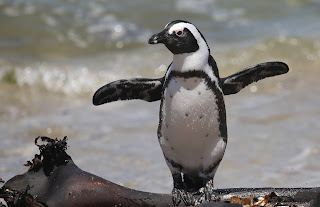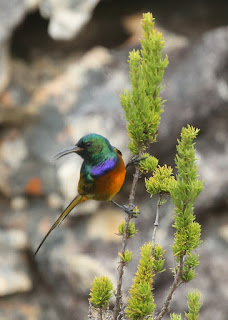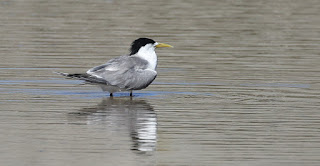We left Pearly Beach on the morning of 25th January, for a three night stay in the Kogelberg. This is a place we had both wanted to visit for quite some time.
The coastline at Onrus.
Birding in these strange times!
Plenty of birds loafing in the bay.
Great crested & Sandwich Terns with Hartlaub's Gull.
Quite common along the foreshore.
We first called in at Onrus, on the outskirts of Hermanus & enjoyed a walk around the coast, which was very pretty. There was a nice selection of the commoner gulls & terns loafing around in the bay.
Vermont Salt Pan.
We then made a quick visit to Vermont Pan, which is on the edge of town. This is a nice piece of wetland habitat amid suburbia. It seems to be managed as a local nature reserve. Two Lesser Flamingoes were the highlights. Although other nice birds included 42 Pied Avocet.
Looking away from Stony Point.
We did & there weren't any!
Immature
Egyptian Goose, surprisingly common along the coast.
African Black Oystercatcher.
This species is doing well these days, due to conservation measures.
In the early afternoon we made a lightning visit to Stony Point Penguin Colony. This was really a recce for a future trip. But it was scenic & interesting.
The road into the mountains.

This area is quite stunning.
Beautiful on the inside as well!
We were very impressed with our home away from home.
Then we climbed up into the mountains & arrived at our destination, which turned out to be superb!
We set about exploring the area.
Delana went for a swim! mad girl!
Cape Francolin were around the accommodation area.
Fiscal Flycatcher on our cabin.
The nest which contained chicks. I could hear them!
Quite common in the highland fynbos.
The road up into the mountains.
Superb, pristine habitat.
Looking back towards the coast.
On the 27th January we drove along the coast & into the mountains again at Buffelstal. One of the Cape Nature guys had told us it was a nice area to visit & so it proved to be.
Piping Cisticola (Neddicky)
Cape Bunting
We enjoyed exploring this area, but we failed to find both our target species: Ground Woodpecker & Cape Rockjumper. There is always the next time!
The mountains come right down to the coast here
in spectacular fashion.
This area is protected especially for the Cape Rockjumper
Looking for the Rockjumper!
In the afternoon we visited the small coastal village of Rooi-Els. This is a very scenic area & prime spot for Cape Rockjumper. However, we yet again failed to find it, despite a lot of effort. It was a lovely walk along the coast though but birds were in short supply.
Smith's Red Rock-rabbit
The area around the accommodation area is irrigated, making for a good food source.
We spent a lovely evening back at our cabin in the mountains. And we had a visitor! Smith's Red Rock-rabbit! It was a new mammal for the both of us & it was wonderful to get such close, prolonged views. Rock-rabbits are nocturnal & therefore may be difficult to see.
Palmeit River Lagoon.
A mixture of Harlaub's Gulls, Common &
Sandwich Terns
Great crested Tern
On 28th January we reluctantly left our mountain hideaway & drove to the Palmeit River Lagoon. This is the same river that we walked along in the mountains. It was a pretty little spot with a good selection of Gulls & Terns on show.
Water Thick-knee
We then drove back to Pearly Beach & made a very quick stop at the Gansbaii Water Treatment Plant, where we saw 6 Water Thick-knee. It had been an excellent few days away.
Birds:
Blue Crane 2; Grey Plover 27; Common Ringed Plover 135; White fronted Plover 14; Whimbrel 112; Curlew Sandpiper 5; Little Stint 160, Common Greenshank 19; Great crested Tern 640.



























































































































